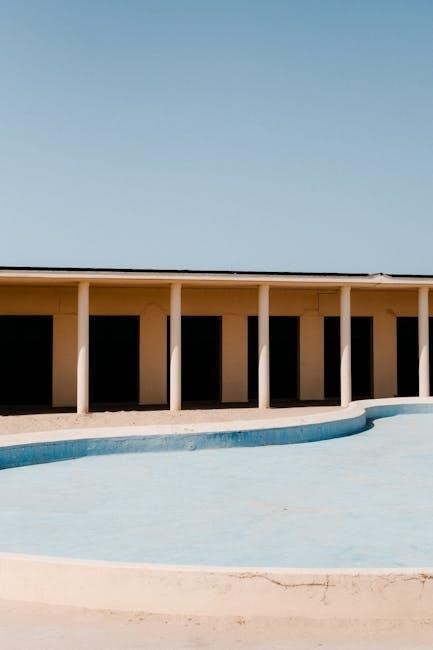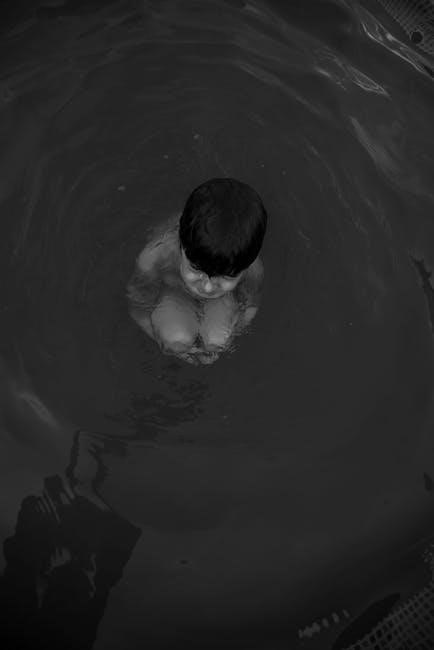Pool Maintenance Guide PDF: A Comprehensive Overview
This comprehensive guide provides a detailed overview of pool maintenance. It includes checklists and guidelines for opening, closing, and maintaining water quality. Keep your pool clean with this guide, safe and functional all year round.
Maintaining a swimming pool involves routine tasks to ensure a clean and safe environment. It is essential for both the longevity of the pool and the health of its users. This involves regular cleaning, chemical balancing, and equipment checks. A well-maintained pool provides a refreshing escape and enhances property value. Neglecting maintenance leads to costly repairs and health hazards. This guide offers simple steps and checklists for effective pool care. Proper pool maintenance is a continuous process, not just a seasonal task. It requires dedication and attention to detail. By following this guide, pool owners can enjoy a sparkling and healthy pool all season. Remember, consistent effort prevents major issues and ensures a safe swimming experience for everyone. Regular maintenance also helps reduce the need for frequent costly interventions by professionals. This approach will help you enjoy your pool more.
Importance of Regular Pool Maintenance
Regular pool maintenance is crucial for several reasons, primarily focusing on safety, hygiene, and cost-effectiveness. Consistent maintenance prevents the build-up of harmful bacteria and algae, ensuring a safe swimming environment. Properly balanced water chemistry protects swimmers from skin and eye irritation. Neglecting maintenance can lead to costly repairs due to equipment damage and water quality issues. Regular checks of pumps, filters, and other components extend their lifespan, reducing replacement expenses. A well-maintained pool also enhances the aesthetic appeal of your property. It provides a clean and inviting space for relaxation and recreation. Routine maintenance involves skimming, vacuuming, and brushing to remove debris. These tasks prevent clogging of filters and maintain water clarity. Ignoring these can lead to cloudy water and the need for expensive chemical treatments. In short, regular pool maintenance safeguards health, saves money, and enhances enjoyment.
Essential Pool Maintenance Tasks
Essential pool maintenance includes regular cleaning, water chemistry balancing, and equipment checks. These tasks are critical for a safe, clean, and functional pool, preventing costly repairs and health hazards for swimmers.
Weekly Pool Maintenance Checklist
Your weekly pool maintenance checklist is crucial for maintaining water quality and preventing problems. Begin by testing the water’s pH, alkalinity, and chlorine levels, adjusting as needed to ensure a safe and comfortable swimming environment. Next, skim the pool surface to remove leaves, insects, and other debris, preventing them from sinking and decaying.
Thoroughly brush the pool walls and floor to dislodge algae and biofilm, keeping surfaces clean and preventing buildup. Empty the skimmer baskets and pump strainer basket, ensuring proper water flow and filtration. Finally, inspect the pool equipment, including the pump, filter, and chlorinator, checking for any leaks or damage.
Address any issues promptly to maintain optimal performance and extend the life of your pool equipment. Regular adherence to this checklist helps ensure a clean, healthy, and enjoyable swimming experience.
Monthly Pool Maintenance Checklist
Your monthly pool maintenance checklist goes beyond the weekly tasks to ensure long-term pool health. Begin by thoroughly inspecting the pool filter, cleaning or backwashing it as needed to maintain optimal filtration. Check the pool’s calcium hardness level and adjust to prevent scaling or corrosion.
Examine the pool walls and floor for any signs of staining or algae growth, addressing these issues promptly with appropriate cleaning solutions. Lubricate the pump motor bearings to ensure smooth operation and extend the motor’s lifespan. Inspect pool accessories, such as ladders, handrails, and diving boards, ensuring they are secure and in good condition.
Finally, check the pool’s overall water level and top it off as needed to maintain proper circulation. By following this monthly checklist, you can prevent costly repairs and keep your pool in top condition.

Water Chemistry and Balancing
Maintaining proper water chemistry is crucial for a safe and enjoyable pool experience. This involves regular testing and adjustment of pH, alkalinity, and chlorine levels to prevent algae growth and corrosion, ensuring water hygiene.
Testing Pool Water Quality
Regularly testing your pool water is essential for maintaining a healthy and balanced swimming environment. Consistent monitoring allows you to identify and address potential issues before they escalate into larger problems. Use a reliable testing kit or take a sample to a local pool supply store for professional analysis. Test at least weekly, or more frequently during periods of heavy use or after significant weather events.
Key parameters to monitor include pH, alkalinity, calcium hardness, and sanitizer levels such as chlorine or bromine. Imbalances in these levels can lead to cloudy water, algae growth, skin and eye irritation, and even damage to pool equipment. Accurate testing provides the data needed to make informed decisions about chemical adjustments, ensuring your pool water remains clean, clear, and safe for swimming. Remember to keep a log of your test results to track trends and anticipate future needs.
Adjusting Chemical Levels (pH, Alkalinity, Chlorine)
Maintaining proper chemical balance is crucial for a safe and enjoyable swimming experience. After testing your pool water, you’ll likely need to make adjustments to pH, alkalinity, and chlorine levels. pH should ideally be between 7.2 and 7.8, while alkalinity should be in the range of 80-120 ppm. Use pH increaser or decreaser to adjust accordingly, following product instructions carefully.
Chlorine levels should be maintained between 1-3 ppm to effectively sanitize the water. Add chlorine granules, liquid chlorine, or use a salt chlorine generator to achieve the desired level. Always test again after making adjustments to ensure the chemicals are balanced and the pool water is safe for swimming. Remember to circulate the water after adding chemicals for proper distribution. Consistent monitoring and adjustment will keep your pool water clean and comfortable.

Pool Cleaning and Filtration
Maintaining a clean pool involves regular skimming, brushing, and vacuuming. Effective filtration is also key. Clean or backwash your filter regularly to remove debris and ensure optimal water clarity and circulation.
Skimming and Brushing the Pool
Skimming and brushing are essential weekly tasks for maintaining a clean and inviting swimming pool. Skimming involves removing leaves, insects, and other floating debris from the surface of the water using a leaf skimmer. This prevents the debris from sinking to the bottom and decomposing, which can affect water chemistry and clarity. Regular skimming reduces the amount of work required for vacuuming.
Brushing the pool walls and floor helps to dislodge algae and biofilm. These can accumulate over time. Use a pool brush with appropriate bristles for your pool surface. This prevents stubborn algae strains from finding a comfortable home on your pool walls or floor.
Effective skimming and brushing can significantly reduce the need for chemical treatments. It also keeps your pool looking its best. Make it a habit to clean the pool as often as possible.
Cleaning Pool Filters
Maintaining clean pool filters is crucial for effective water circulation and filtration. Pool filters trap debris, dirt, and other particles, preventing them from clouding the water. There are three main types of pool filters: sand, cartridge, and diatomaceous earth (DE). Each type requires a different cleaning method.
Sand filters need backwashing, which involves reversing the water flow to flush out the trapped debris. Cartridge filters should be removed and rinsed with a garden hose. For DE filters, backwashing is also necessary, followed by the addition of fresh DE powder.
Regular filter cleaning ensures optimal performance. This helps to extend the lifespan of the filter and maintain water clarity. Neglecting filter maintenance can lead to reduced water flow, increased pressure, and decreased effectiveness in removing contaminants.

Opening and Closing the Pool
Proper pool opening and closing procedures are essential for seasonal maintenance. These checklists ensure the pool’s longevity and water quality. Following these steps prevents damage and ensures a clean, safe swimming environment.
Pool Opening Checklist
Opening your pool for the season requires careful preparation. Start by removing the pool cover and cleaning off any debris. Inspect the cover for damage and store it properly. Next, check the water level and fill the pool as needed. Reconnect all filtration system components, including pumps and filters.
Inspect all pool equipment for signs of wear or damage and repair or replace as necessary. Clean the pool thoroughly, brushing the walls and vacuuming the floor. Test the water’s chemical balance, adjusting pH, alkalinity, and chlorine levels as needed.
Run the filtration system for at least 24 hours to circulate and purify the water. Finally, inspect all safety equipment, such as life rings and fences, to ensure they are in good condition and ready for use. Following these steps ensures a safe and enjoyable swimming season.
Pool Winterization Checklist
Proper winterization is crucial to protect your pool from damage during the off-season. Begin by thoroughly cleaning the pool, skimming, brushing, and vacuuming to remove all debris. Next, test and balance the water chemistry, ensuring proper pH and alkalinity levels. Lower the water level to below the skimmer and return jets.
Drain all pumps, filters, heaters, and chlorinators to prevent freezing. Remove drain plugs and store them in a safe place. Blow out all plumbing lines using an air compressor and plug the lines with expansion plugs. Add winterizing chemicals to prevent algae growth and scaling.
Cover the pool with a durable winter cover, securing it tightly to prevent debris from entering. Inspect the cover regularly throughout the winter and remove any accumulated snow or leaves. Disconnect and store pool equipment indoors to protect it from the elements. Following these steps will help ensure your pool remains in good condition throughout the winter.

Troubleshooting Common Pool Problems
Even with diligent maintenance, pool owners may encounter various issues. Cloudy water is a frequent problem often caused by poor filtration, improper chemical balance, or high bather load. Check the filter and chemical levels, and consider shocking the pool. Algae growth can lead to green or black water.
Brush the pool, shock it with chlorine, and use an algaecide. If problems persist, consider the circulation. Scale buildup, usually white or gray deposits on pool surfaces, results from high calcium hardness or pH. Lower the pH and use a scale remover. Clogged filters reduce circulation and cleaning efficiency.
Backwash or chemically clean the filter regularly. Leaks can cause significant water loss. Identify and repair leaks promptly to prevent structural damage. Addressing these common problems quickly will help maintain a clean, safe, and enjoyable pool environment. Consulting a professional may be necessary for complex issues.
